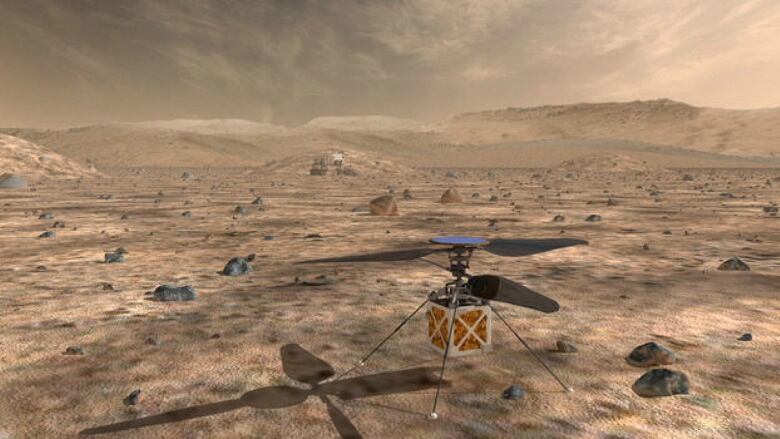NASA to fly tiny helicopter on next mission to Mars
Advancement of consumer technology played a major role in the chopper's development

In 1971, thefirst vehicle drove on the moon. And in 2018, the first car began cruising our solar system. Next up? The first helicopter to take flight on another planet.
NASA announced last week that as part of the next Mars mission, a tiny, lightweight helicopter will zip around the Red Planet on a 30-day test flight.
Dubbed the Mars Helicopter, the U.S. space agency is aiming to launch it alongside the Mars rover in July 2020.
Once the spacecraft carrying the two vehicles touches down, the helicopter will be detached and the six-wheeled roverwill drive a safe distance away torelay commands.After the helicopter's rechargeable lithium-ion batteries are charged up and ready to go, the Mars Helicopter will take to the skies and make history.
The Mars 2020 mission isexpected to reach our planetary neighbourby February2021.
With two counter-rotating blades, the helicopter its main body about the size of a softball will weigh just 1.8 kilograms. In order to account for the planet's thin atmosphere, its blades will rotate 10 times faster than the blades of a standard helicopter: roughly 3,000 rotations per minute.
Building a helicopter able to fly on Mars involved some clever engineering. Marshas about one per cent of Earth's atmosphere, with very thin air. Andwhile scientists hadpreviously proposed flight on Mars was possible if you builtsomethinglight enough, with rotors that spun fast enough, the technology just wasn't there until now.
Consumer tech goes to Mars
Greener techhashad a hand in making this happen, due to advancements in high-density, low-mass batteries, as well as more efficientsolar cells. There's also been the realization of smaller, more lightweight parts, like the helicopter's altimeter,accelerometerand various computer components. And tech from autonomous cars including the cameras that ensure the car is in its own lane is being used.
"All of this has all just become possible in recent years, mostly from the advancement of commercial electronics," said Mimi Aung, the Mars Helicopter project manager at NASA's Jet Propulsion Laboratory."So we took advantage of all of that."

In order to test the helicopter in Earth's heavier atmosphere, NASA scientists first built a one-third scale model.Theythentested it in vacuum chamber that waspumped toa near-vacuum environment and refilled with carbon dioxide to create anatmosphere similar to that of Mars.
The tests proved successful there, but the true test will be on Mars itself.
'Mars? Really?'
While the team has faced a number of challenges in designing and building the helicopter, Aung said the biggest wasputting it all together in such a small package.
"I think there was always this question of:'Mars? Really? There isn't enough air,'" said Aung."And then you get the analytical models that say you can do itand it looks like you can do it.But [then it was] can we build it?"
- NASA tests nuclear power system for future astronauts on Mars
- Why living in space may require more than new technology
Even with all the necessary components in place to get the helicopterto lift into the air on Mars, the team also had to consider the need for and weight of autonomous capabilities.
"Staying under that two kilograms that was the hardest thing;to fit all those capabilities into the mass constraint," saidAung.
While instructions will ultimately be sent from Earth, once they are received by the Mars Helicopter (via the rover, which can transmit signals from up to a kilometre away), the chopperwill be operatingon its own.
So why would we need a helicopter on Mars? The agency ishopingit can ultimately be used as a scout, providing a new way to explore the Red Planet and conducting research in locations inaccessible to vehicles and, one day, humans.
And while it's still a few years away, Aung said that come 2020, she and her team will be anxiously awaiting the results of the historic mission, allowing theirconcept to truly takeflight.
"To be able to say 'here it is, this is possible,and this is how you build it,' has been very satisfying," she said.












_(720p).jpg)


 OFFICIAL HD MUSIC VIDEO.jpg)
.jpg)



























































































